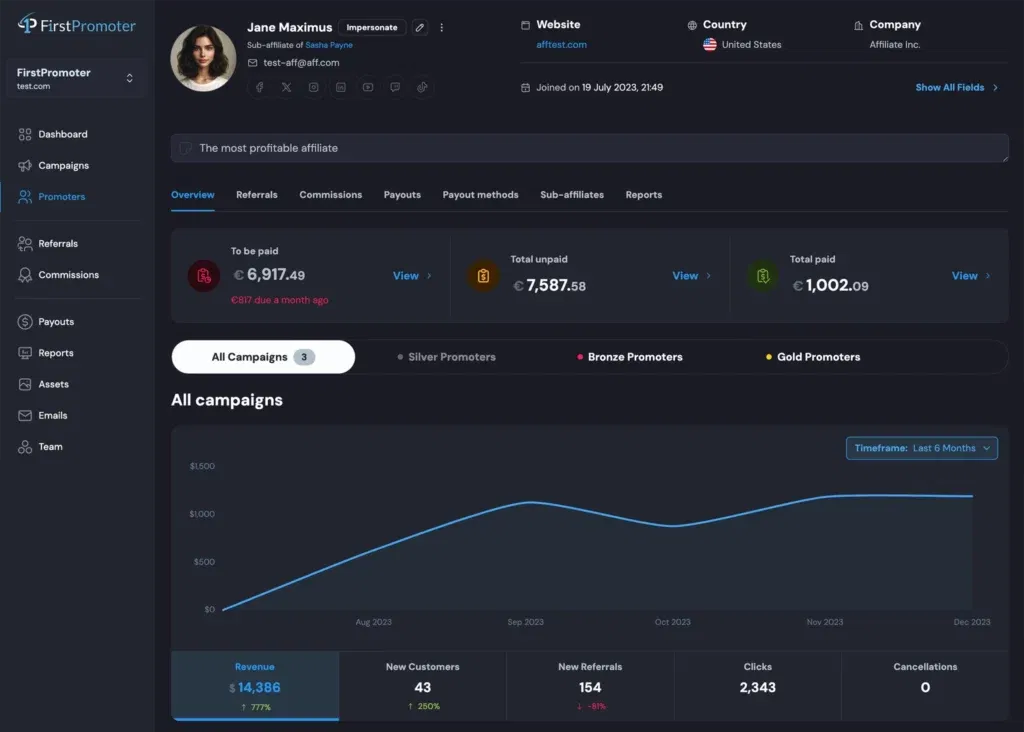Affiliate marketing holds great potential to drive massive returns on investment for e-commerce brands. With over 50% of marketers ranking affiliate campaigns as one of their top acquisition channels, there’s no doubt about its effectiveness.
But here’s the problem: many brands launch an affiliate program and expect results without a strategy. They end up spending more time managing affiliates than generating revenue. However, building a successful affiliate program requires strategic planning, consistent support, and genuine connections with your affiliates.
If your current program isn’t yielding the results you expect, you’re likely falling victim to some common pitfalls. We’ll discuss the six affiliate marketing mistakes you might be making and, more importantly, how to fix or avoid them to drive better ROI.
Table of Contents
6 Biggest Affiliate Marketing Mistakes to Avoid in 2025

1. Prioritizing Quantity Over Quality
It’s tempting to onboard every influencer or affiliate who signs up for your program because you want to scale up quickly. After all, more affiliates should equal more sales, right?
Not quite.
For your affiliates to sell your products successfully, they need to have the right audience, meaning they should be in a niche similar to or complementary to your brand.
For example, a skincare brand collaborating with 50 micro-influencers across various niches, including unrelated ones, might not reach their goals. However, they can triple conversions if they switch to 10 beauty-focused affiliates.
Instead of chasing or accepting every affiliate marketer, follow the steps below.
Here’s What to Do Instead:
- Vet Your Affiliates: Check their audience, niche relevance, past campaign performance, and overall reputation. Ensure their values align with your brand. For example, if you sell travel bags and luggage, like BÉIS, you should prioritize a partnership with travel influencers like Kate Newman.
- Track the Numbers: While vetting an affiliate’s profile, look beyond the follower count. A high follower count with engagement on posts often indicates bot activity. For example, a creator with 1000 followers on Instagram but just two likes on their posts likely has many bot followers. Some creators buy followers to boost their credibility. So, always prioritize the engagement rate and click-through rate.
- Send Tailored Outreach: Skip the spammy DMs. A personalized pitch to the right affiliate builds trust and gets better results. It sets the tone for the relationship and becomes the foundation of a long-lasting, profitable affiliate partnership.
Don’t fall for vanity metrics. Every affiliate you work with should connect with your ideal audience.
2. Neglecting Affiliate Onboarding

You can’t expect affiliate marketers to promote your product well if you don’t equip them properly. It’s like sending a team into a game with no playbook. What do you think happens then? You leave them feeling confused or guessing about things like how to use the affiliate software, your brand values, and even how the affiliate product works.
A Better Approach:
- Create a quick starter guide. This should help them navigate the affiliate tracking software and find links, banners, product information, commission breakdowns, rules, and other relevant details.
- Use email marketing to send reminders, updates, and best practices.
- Share brand assets, including high-quality product photos, messaging templates, and SEO-friendly keywords, to help them succeed.
- Provide answers to frequently asked questions to equip your affiliates with sufficient brand and product information for effective marketing.
👉 The best affiliate marketing strategy starts with clear onboarding. That’s how you set your affiliates up for success and minimize drop-offs.
3. Failing to Build Real Relationships with Affiliates
One of the common mistakes brands make in affiliate marketing is treating it like a one-time transaction. The right way to look at it is as a partnership. Your relationship with the affiliates shouldn’t stop at the onboarding process.
Many brands rely too heavily on automated emails or generic support tickets. That’s a fast way to lose trust with your network of promoters.
Build Stronger Relationships By:
- Personalizing check-ins. Engage with top affiliates through direct messages or quarterly video chats. Get to know them, find out how they are doing, and what they need. This shows that they have your support.
- Sharing relevant newsletters to maintain contact with them. You can share marketing tips or new brand or product information with your affiliates via newsletters.
- Creating community spaces like Slack groups or private forums to keep in touch and also facilitate collaborations among affiliates. With this, they can start doing partnership videos to promote your products.
👉 Strong relationships drive loyalty, and loyal affiliates drive consistent affiliate sales.
4. Setting Unclear or Unrealistic Goals

Another of the big affiliate marketing mistakes brands make is jumping into a campaign without defining what success looks like. Or worse, expecting affiliates to generate thousands in revenue overnight.
Don’t make that mistake. Without realistic and data-backed goals, you may end up wasting resources or be disappointed with the results.
Smart Brands Do This:
Set Specific, Measurable, Achievable, Realistic, and Time-Specific (SMART) Goals
Instead of vague goals like “increase revenue,” your campaign goals should be SMART. For example: “Increase affiliate-driven traffic by 25% in Q3,” “Grow affiliate sales by $5,000 this month,” or “Hit a 3% conversion rate on affiliate landing pages in 2 months.”
Benchmark with Your Own Data
Start with your current stats. Look at key metrics like:
- Average conversion rate: The percentage of people who visit your website/shop AND make a purchase.
- Average order value (AOV): How much the average customer spends per order.
- Current traffic from affiliates or other channels.
Here’s a simple example of how you’d use these metrics:
Let’s say your AOV is $40, and your site converts at a 2% rate. That means for every 100 affiliate clicks, you could expect two purchases worth about $80 total. To make $5,000 in affiliate revenue, you’d need roughly 6,250 high-quality clicks.
That’s your baseline.
From there, you can reverse-engineer how many affiliates you need, what traffic volume they should drive, and how strong your offer needs to be.
Next, Share These Numbers (Goals) With Your Affiliates
Sharing these goals helps affiliates understand what success looks like and how they can realistically contribute to it. You can also incentivize them with bonuses for meeting specific benchmarks.
5. Choosing the Wrong Product
Even top affiliates may find it challenging to sell a “weak” product or a poorly positioned offer. If your offer isn’t converting, it might not be the affiliate’s fault. The wrong product or service—even the wrong messaging—will tank your campaign.
How to Choose the Right Affiliate Product

Ensure Audience Alignment
Who’s your target audience, and what do they like? The product you choose should align with their demographics, interests, pain points, and values. This makes it easy to sell because you’re pushing products they care about.
🎯When the product feels tailored to your audience, it feels less like selling and more like a recommendation when your affiliate marketers promote it.
Evaluate the Product Value
Consider products that offer a clear benefit and ideally have a unique edge or backstory. The latter serves as evergreen marketing material. For instance, a sustainable phone case brand that plants a tree for every sale is more compelling than a cheap plastic case, especially for eco-conscious buyers.
This kind of unique edge is relevant because people buy stories. When you add this dimension, you create solid potential for recurring income from affiliates.
Check the Commission Structure
Low commission rates don’t attract successful affiliate marketers. At the same time, you have to ensure a net gain on your products after affiliate sales. This is another reason why choosing the right affiliate products is key; the math must make sense for both parties.
So, look for products with decent margins that allow you to offer competitive commissions without eroding your bottom line.
👊 One subpar affiliate product can significantly hurt your brand reputation. So, choose value over quick wins.
6. Skipping the Analytics and Optimization Work
Another mistake you can make in your affiliate program is ignoring analytics. Without analytics, you’re running blind. And if you don’t learn and optimize your marketing efforts, you’re leaving money on the table.
Instead of Ignoring Data:
Get Reliable Affiliate Marketing Tools to Track Performance
This step is the foundation for getting accurate data. With the right tracking software, you can monitor essential metrics such as clicks, conversion rates, average order value, and commission-to-revenue ratio. These metrics reveal your top performers and show how the entire affiliate program is affecting your bottom line.
Segment Your Top-Performing Affiliates
Your top-performing affiliates are a mix of those who bring the most traffic and those who bring loyal, repeat buyers. How do you discover these affiliates? Simply through your affiliate tracking tool. That’s why it’s important to choose the right tool that provides comprehensive analytics.
Once you identify these top affiliate marketers, dig into their strategy. Learn their approach to affiliate marketing. This insight shows which channels or content types yield the best results for your brand. Then, use it to shape how you recruit new affiliates. Look for affiliates with similar audiences or approaches.
Also, consider sharing a top-performer’s playbook with newer affiliates to boost results across the board.
Finally, Don’t Treat Analytics as a One-Off Task
Tracking only works if you act on it. When you check your analytics and see what’s working, replicate and share it with your affiliates. If you are not satisfied with the results, find ways to improve them. Share what’s working and what’s not working with your affiliates.
Affiliate Marketing Mistakes Happen, But Now You Know Better
So, what’s your next move?
Maybe it’s rewriting your onboarding guide, fostering better relationships with your affiliates, or even switching up your affiliate tools. Whatever it is, taking action is more valuable than simply being aware. So, start implementing what you’ve learned now.
If you want expert guidance on optimizing your affiliate strategy, Vivian Agency is one message away. Contact us here or book a call with us for a one-on-one session.




